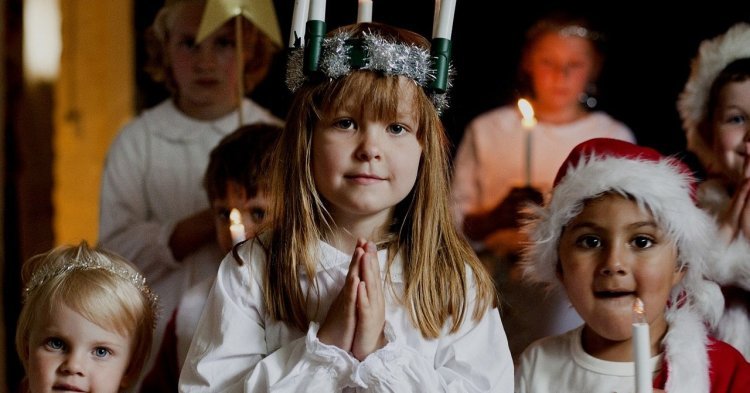Uppsala, Sweden, 2018. It was a chilly October night – the kind that feels both full of possibility and tinged with the knowledge that the real winter is still to come. I was cycling home from a concert at the university when suddenly, I saw a green flare streak across the dark sky and hover above the Uppsala Cathedral. All around me, people stopped in their tracks to marvel at the sight in collective silence. It was an almost spiritual moment, and one which I often come back to when I think about the place of religion in Sweden. I do not think of pious worshippers filling up the pews for Sunday mass, but rather this moment – this shared appreciation of beauty, nature, history and community.
The Uppsala cathedral, consecrated in 1435, is the largest and tallest cathedral in Scandinavia, as well as the coronation site of most of Sweden’s kings. The city of Uppsala is also home to the headquarters of the Church of Sweden (CoS), an Evangelical Lutheran church with approximately 5,8 million members. Given that the population of Sweden is just over 10 million, this number is quite significant.
One might easily think that if 57% of Sweden’s population belongs to the Church of Sweden, then Sweden must be quite a religious country. In reality, the opposite holds true. According to a 2010 Eurobarometer report, just 18% of Swedes believe there is a God – of all the EU member states, only Estonia and the Czech Republic reported lower levels of belief. When it comes to church attendance, the numbers are even lower, with just 3.8% of the population attending religious services weekly.
This begs the question : if so few Swedes believe in God and regularly attend church, why does the Church of Sweden still have so many members ? Part of the reason for this is that up until 1996, Swedes automatically became members at birth. Nowadays, people have to actively choose to join, but those born before 1996 have to make a conscious decision to leave. Many Swedes are also leaving the church for financial reasons. In the lead-up to the Church’s official divorce from the state in 2000, tax forms were released revealing for the first time exactly how much money Swedes were donating to the Church (approximately 1,2% of taxable income). Needless to say, this revelation led a significant proportion of members to renounce their membership. However, this still does not entirely explain why almost two thirds of the Swedish population belong to the Church of Sweden, twenty years after the country’s official secularisation. It also does not explain why close to half of all Swedish newborns are baptised in the church or why three out of every four funerals take place within the church.
Interestingly, while most Swedes view their country as a sort of poster child for secularism, the influence of Lutheranism on Swedish society is still very apparent. Consider for example the“confirmation camps” which many Swedish children attend, although most claim that they are just normal summer camps. Moreover, while Swedish public schools have a requirement to be non-confessional, it is common to find schoolchildren searching for Easter eggs and hanging Christmas stars in the windows of their classrooms. On Santa Lucia (13 December), Swedes across the country gather to sing religious hymns and wear wreaths of candles on their heads to commemorate the Light of Christ. The question thus is : are they then practicing religion, or are these activities mere enactments of non-religious cultural practices ?
American sociologist Nicholas Demerath uses the idea of ‘cultural religion’ to explain this appreciation of rituals and traditions in Sweden. He explains that while we see an increasingly secular people losing faith, there remains a nostalgic fondness for it and a widespread adherence to a “distant shared memory”. But what does it mean for Swedish secularism if this “distant shared memory” is not shared by all ?
Over the past few decades, globalisation and immigration have transformed Sweden into a melting pot of different ethnicities and religions. Moreover, while membership of the Church of Sweden is declining, recent years have seen the membership of other churches and religions increase [1]. Non-Christian immigrants arriving in Sweden thus encounter something of a paradox : Sweden is a very secular society but also has a strong Lutheran heritage, as symbolised by the more than 3,500 Church of Sweden buildings located across the country. While the secular character and religious neutrality of the state offer religious minorities space to practice their religions, much of Swedish society and politics is still premised on certain Christian notions of what religion should be.
This has been taken to the extreme recently by the far-right, ethnonationalist Sweden Democrats (SD) party, which has emphasised Christianity as fundamental to Swedish culture and criticised the Church of Sweden for being ‘soft’ on Islam : “Islam is protected… to the point of absurdity,” said former CoS priest and SD supporter Helena Edlund. While the SD party still struggles to form coalitions and remains quite isolated in the Swedish Riksdag, it has nonetheless received a significant increase in support, becoming the third largest political party in 2018.
Many experts say that a key reason for this growing support is a widespread fear in some circles that Islam – which many perceive as a strong, rule-driven religious culture – will displace or dominate secular Swedish culture, rendering it wholly different in the process. With Sweden’s Muslim population projected to reach 21% by 2050, debates on Sweden’s secular culture are becoming more and more polarised.
But increased polarisation is the opposite of what is needed right now. Rather, if it wants to uphold its self-professed image as a tolerant, egalitarian society, then Sweden will have to critically reflect on the extent to which its particular brand of secularism is informed by its own religious heritage. The question of course is whether it truly wants to.


Suivre les commentaires : |
|
